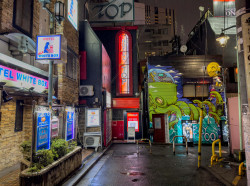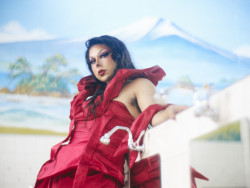
The trouble with most art, from the classics to the most avant-garde, is that it sits or hangs there in the gallery, waiting to be seen. In other words, it’s passive.
There’s quite a different vibe at the “Visual Deception II” exhibition at Bunkamura The Museum, where much of the art has a life of its own, impacting on the senses in a more instinctual way that bypasses the intellect. Building on an earlier, successful show from 2009, the second in the series contains plenty of art that tries to evoke visceral reactions and sensations rather than polishing socio-political agendas.
A good example of this is Daniel Rozin’s Wooden Mirror (2014), a mosaic of flickering wooden squares with hidden cameras that track and instantly represent our movements. The effect is like stumbling upon some natural wonder rather than a work of art, and the experience is all the fresher for it.
A similar effect, but with greater humor, can be found in Shigeo Fukuda’s Underground Piano (1984)—a smashed-up, chaotic jumble of broken piano pieces, which are so cunningly arranged that in a mirror next to the work they miraculously come together again to recreate the perfect form of a piano. The effect is visceral and raw, more like a wonder of nature than something that won art council funding or ticked the right boxes for trendy curators and collectors.
The exhibition spans a wide variety of genres, including sculpture, hyper-realism, surrealism, op-art and photography—but it also stretches back in time, revealing that art’s ability to pull off simple visual trickery has always had a strong appeal, and may be something that it needs to focus on more.
Some of the earliest works in the show are by the great 16th-century Italian painter Giuseppe Arcimboldo, who created paintings of people made up of various objects. His work The Sommelier (1574) is composed from various jugs, kegs and tankards assembled in human form. The effect is more comical than visceral, although there’s also an element of the creepy and the surreal. Indeed, Arcimboldo was viewed as a precursor by the Surrealist movement, who are well represented here, with several works by René Magritte, Salvador Dali and Méret Oppenheim, whose Squirrel (1969) is a pint of beer with a squirrel’s tail.
These surrealist works, along with the graphic tessellations of Dutch print artist M. C. Escher, suffer from being all too familiar, but are nevertheless rewarding to look at as examples of “art history.”
More effective are the relatively unknown works, which become more immediate because you don’t see them through the filter of art history and cliché, such as Evan Penny’s Female Stretch, Variation #2 (2011), a hyper-realistic sculpture of a woman’s head, except that it’s taller than you and incredibly thin and elongated, like a three-dimensional hall of mirrors image.
This is art that works best through raw reaction. Once you start wondering if the artist is commenting on anorexia nervosa or the cult of “thin” in modern society, it immediately loses its power.
Until Oct 5, Bunkamura.







